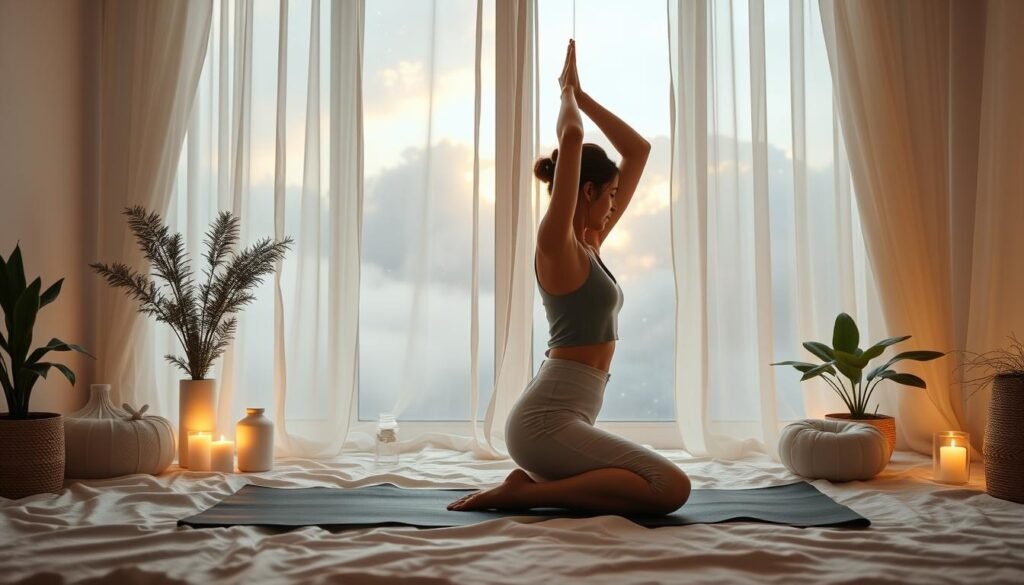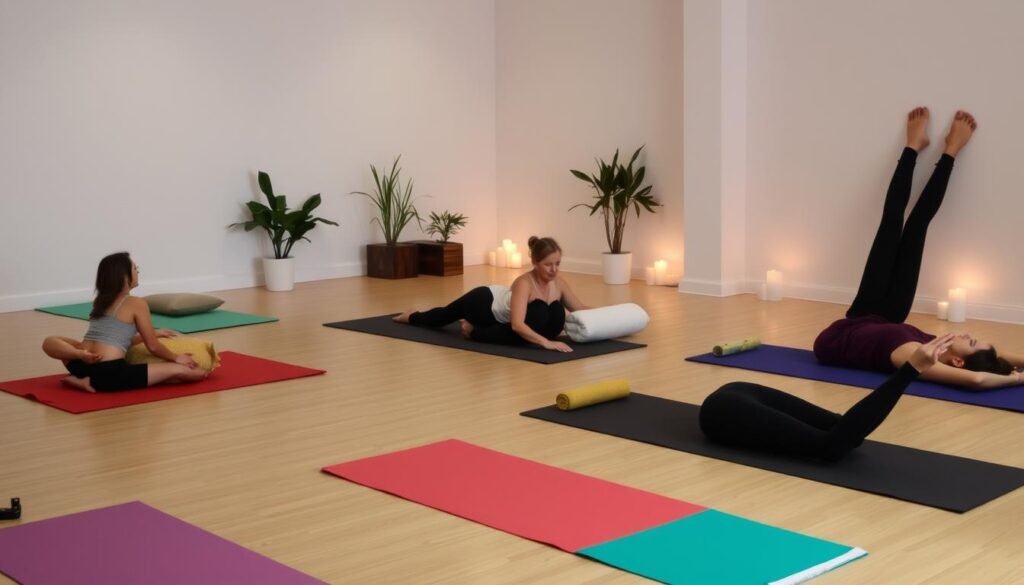Millions worldwide can’t find peace at night, failing to rest well. The major cause for insomnia includes ongoing worries. Thoughts about the past and future disrupt sleep. Yoga can help. Trying yoga before bed could be the key to battling sleeplessness and boosting sleep quality.
Anyone can practice yoga. It doesn’t matter how old you are or your fitness level. Breathing methods like Belly Breathing and Alternate Nostril Breathing (Nadi Shodhana) calm the mind. Also, yoga nidra, known as yogic sleep, offers a deep relaxation experience through guided meditation, focusing on breathing techniques.
Yoga experts have their favorite poses, like Legs-Up-the-Wall (Viparita Karani), known for healing effects. Savasana, or the Corpse Pose, is also highly recommended for easing stress and improving sleep. Follow experts’ tips and enjoy routines such as drinking chamomile tea for a peaceful night. Learn more at this resource.
Key Takeaways
- Millions struggle with sleep issues, primarily due to racing thoughts.
- Yoga for sleep can be practiced by anyone, making it inclusive and accessible.
- Breathing techniques within yoga promote relaxation and improved sleep quality.
- Yoga nidra is a beneficial meditation practice that aids in achieving deep relaxation.
- Expert advice suggests that certain poses can effectively relieve stress before bedtime.
Introduction to Yoga for Sleep
Adding bedtime yoga to your night routine can improve your sleep and bring peace. Using restorative yoga poses like Child’s Pose and Legs-Up-the-Wall before bed eases tension. These movements improve circulation and body position. Having a regular routine sets the stage for better sleep.
Calming techniques such as deep breathing can make the experience even better. They help you move from your busy day into a peaceful night.
Some restorative yoga poses last between 10 to 25 minutes, perfect before bed. The Legs-Up-the-Wall Pose, for example, relaxes your nervous system and helps you unwind. The perks of bedtime yoga go beyond just relaxing your body. They also bring mental clarity and balance your emotions.
Yoga Nidra is a flexible practice ranging from 15 to 45 minutes. It’s great for dealing with insomnia and can be adjusted for anyone’s needs. Sticking to a routine can be a game-changer, helping both mind and body relax after a long day.
Understanding Insomnia and Its Effects
Insomnia is quite common, affecting about one-third of all adults. This condition brings significant daily challenges. The effects of insomnia include chronic fatigue, difficulty concentrating, and mood changes. People with chronic sleep problems often feel their life quality decreasing. They usually face more stress and anxiety too.
Studies show stress and anxiety often cause sleep issues. It’s essential to handle these problems to sleep better. Yoga can help a lot, easing symptoms of insomnia. Research found mind-body therapies like yoga reduce insomnia’s severity effectively.
A 2020 review showed yoga is especially helpful for women, including those in menopause. Although high-intensity yoga might not aid sleep, gentler types like Gentle Hatha and Restorative yoga help. These softer styles can relieve chronic sleep issues.
Adding yoga to your nightly routine can really help you relax and sleep better. Focusing on calm settings, relaxation practices, and certain poses supports this goal. For more tips on improving sleep with yoga, check this link.

Benefits of Incorporating Yoga for Sleep
Yoga has many benefits for those who struggle to sleep. It not only helps with insomnia but also makes sleep better. It creates a calm space that makes it easier to rest at night.
Alleviates Symptoms of Insomnia
Doing yoga regularly can ease many signs of insomnia. In the U.S, many adults don’t get the seven recommended hours of sleep. Less than 35.2% sleep enough. But, adding yoga to your nightly routine can fight off sleep loss. It also reduces anxiety, helping you get the rest you need.
Improves Sleep Quality and Overall Life
Doing gentle yoga before bed can make your sleep better. Studies show that older adults and pregnant women, who do yoga, sleep more soundly. This highlights yoga’s role in not just sleep but also life quality.
Promotes Relaxation
Yoga helps relax by reducing cortisol levels and lessening stress. Through mindfulness, it can boost melatonin, aiding better sleep. A regular yoga practice at night tells your body it’s time to calm down. This helps foster good sleep habits.

Effective Restorative Yoga Poses
Adding restorative yoga poses to your nightly routine can greatly boost relaxation. It prepares your body for a deep sleep. These gentle movements soothe your nervous system and ease muscle tension. This makes them perfect to practice before hitting the bed. Here are three restorative yoga poses that help with tranquility and sleeping better.
Legs-Up-the-Wall Pose
The Legs-Up-the-Wall Pose, or Viparita Karani, calms your mind and body. By lying back and resting your legs against a wall, your blood flows better. It also gently stretches your hamstrings. The pose fights insomnia, eases anxiety, and brings you into deep relaxation.
Corpse Pose
The Corpse Pose, or Savasana, is key for better sleep. You lie on your back and release all body tension. It deeply relaxes you, lowers your blood pressure, and boosts energy levels. Including this pose in your nighttime routine can improve your sleep quality.
Child’s Pose
Child’s Pose, or Balasana, is yet another great pose for restoration. It gently stretches your back, hips, and thighs. Plus, it relieves tension in your shoulders and neck. This pose helps you relax and lessens stress and anxiety. It’s helpful for a calm night’s sleep.

Yoga for Sleep, Insomnia or Deep Relaxation Techniques
Specific techniques can make restorative yoga more effective for sleep. Breathing exercises can kickstart the body’s relaxation response. This helps reduce stress and gets the mind ready for sleep.
Breathing Exercises
Breathing exercises are great for calming the nervous system and cutting down on stress. Techniques like diaphragmatic breathing and the 4-7-8 method help you focus on your breathing. This focus can bring peace by lowering your heart rate and stress hormone levels.
- Diaphragmatic Breathing: Enhances oxygen flow, encouraging deep relaxation.
- 4-7-8 Method: Involves inhaling for 4 seconds, holding for 7, and exhaling for 8 to ground the mind and body.
Yoga Nidra
Yoga Nidra is key for relaxation techniques that improve sleep. It’s a kind of meditation that finds the middle ground between being awake and asleep. Through visualization and mental imagery, Yoga Nidra can better your sleep quality. This is especially true for those facing insomnia.
- Guided Visualization: Helps in creating a calming mental space.
- Body Scan: Encourages awareness of physical sensations, fostering relaxation.
Adding breathing exercises and Yoga Nidra to your nighttime routine can be very helpful. These practices ease anxiety and encourage relaxation, leading to a better night’s sleep.
| Technique | Benefits |
|---|---|
| Diaphragmatic Breathing | Enhances oxygen supply, promotes calmness |
| 4-7-8 Method | Regulates heart rate, reduces anxiety |
| Yoga Nidra | Guides to deep relaxation, improves sleep quality |
Creating a Calming Bedtime Routine
Creating a calming bedtime routine is crucial for good sleep hygiene. It tells your mind it’s time to relax, setting the stage for deep sleep. This routine can include gentle yoga, deep breathing, and other methods to relax.
Studies show the benefits of yoga for fighting insomnia. People who do yoga or similar activities before bed notice they fall asleep faster and sleep better. Regular yoga practice helps you feel more at ease, less stressed, and ready for sleep.
Having the right environment for sleep also helps. A room that’s quiet, dark, and cool helps prevent sleep interruptions. Eating a light snack like fruit or yogurt before bed can also help your body get ready for sleep.
Key steps for a calming bedtime routine include:
- Keeping a consistent time for going to bed and waking up helps program your sleep cycle.
- Doing deep breathing exercises to relax more deeply.
- Reading a soothing book in dim light helps prepare your brain for sleep.
- Staying away from screens to avoid blue light interfering with sleep hormones.
- Writing in a journal or making a to-do list can clear your mind before bed.
Small changes in your nightly habits can lead to a better bedtime routine. By sticking to these practices, you can improve your sleep dramatically. This supports your overall health. Learn more about making the best bedtime routine here.
Tips for Successful Bedtime Yoga Practice
Adding yoga to your bedtime routine can help improve your sleep. It’s important to pick the right yoga tips for the evening. Choose calm and relaxing poses and avoid intense workouts before bed.
Having a set time every evening for yoga is key. Do gentle stretches and breathing exercises then. This tells your body it’s time to wind down. Set goals that are easy to reach. This will help you keep doing yoga every day. Just a few minutes can make a big difference.
Some yoga poses are great for helping you sleep. Child’s Pose, Legs-Up-the-Wall, and Corpse Pose work well in bed. Using items like blankets and pillows can make these poses even better. You can hold these poses for one to three minutes to get comfortable.
Watching your progress can show you how yoga makes sleeping easier. Doing yoga often means less stress and a calmer nervous system. Noticing even small improvements can keep you motivated.
| Pose | Duration | Benefits |
|---|---|---|
| Child’s Pose | 1-3 minutes | Deeply relaxes the back and calms the mind |
| Corpse Pose | 3 minutes | Promotes total relaxation and stress relief |
| Legs-Up-the-Wall | 1-2 minutes | Enhances blood circulation and relieves tension |
| Supine Twist | 2-3 minutes | Releases tension in the back and aids digestion |
| Seated Forward Bend | 1-2 minutes | Stretches the spine and calms the nervous system |
How Yoga Affects Your Sleep Quality
Adding yoga to your nighttime routine improves sleep quality. About 55% of people doing yoga see better sleep patterns. This shows yoga’s big impact on sleep, helping those with insomnia and other sleep troubles.
Studies show that yoga helps people fall asleep quicker and sleep more deeply. Restorative and hatha yoga, known for their calming effects, aid in sleep improvement. They relax the mind and body. Also, yoga poses that stretch and relax muscles ease tension and boost blood flow. This helps you get into a sleep-ready state.
Yoga’s benefits for sleep also include stress, anxiety, and depression reduction. This is especially true with yin yoga. Adults dealing with insomnia, particularly women and the elderly, notice better sleep after doing yoga. Yoga also eases restless leg syndrome symptoms, benefiting various people.
| Demographic Group | Reported Benefits of Yoga for Sleep |
|---|---|
| Pregnant Individuals | Fewer sleep disturbances |
| Women with Insomnia | Improved overall sleep |
| Older Adults | Enhanced sleep quality |
| Individuals with RLS | Reduced symptoms |
Doing 2-3 gentle yoga sessions a week can slowly improve sleep. Using support props and focusing on breath are helpful. Practicing yoga 30 minutes before bed is best. It leads to restful nights and healthier sleep cycles.
Conclusion
Yoga is a powerful way to fight insomnia and better your sleep. It does more than just help you relax. Through poses and breathing, it improves your overall health. For those dealing with long-term insomnia, yoga before bed can really help.
People who do yoga often find they sleep better. They also feel less anxious and sad. These problems often happen with insomnia. Yoga helps by making you calm and balancing your mood. This is especially true for pregnant women and those in menopause. About 55% of those who practice yoga see better sleep.
Starting a yoga routine for sleep might take time to work. But the long-term sleep benefits are worth it. Yoga uses calming practices and specific techniques. This helps you get deep, healing sleep and tackles insomnia’s main issues.